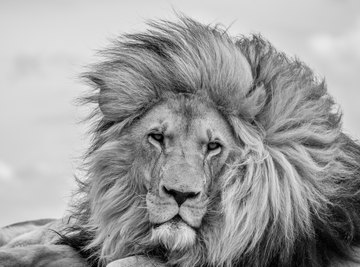
Mammals have the most complex nervous system on the planet, with humans being the most advanced. The nervous system works with the senses to transmit information to the mammal's brain, a process that takes less than one-hundredth of a second. The brains of mammals, especially humans, are wired to react to the world quickly to protect the animal from danger and to allow it to assess immediate environment easily.
Type
The nervous system of a mammal is based on the brain and the spinal cord, which sends and receive signals from the rest of the body. Signals from the body are sent through nerve endings (or receptors) to the brain, where neurotransmitters send a signal to allow all mammals to feel pain or other sensory information. The nervous system of a mammal is divided into four main parts: the central nervous system, the peripheral nervous system, the somatic nervous system and the autonomic nervous system. Each of the parts of the nervous system of a mammal works in a different way, and performs a different job in the body to maintain health and to allow you to react to the world.
Benefits
The basic parts of a nervous system are the sensory receptors, the brain and the spinal cord. All mammals have nerve endings spread over their body in order to receive and send signals to external stimuli. The sensory organs, such as the skin and the eyes, help a mammal interpret what is happening in the external environment and in the case of a dangerous situation, allow reflexes to help the mammal avoid harm. The nervous system is also responsible for maintaining homeostasis, or a functioning and stable state, for all the organs in the body. Every mammal uses part of their central nervous system to maintain their heartbeat, breathing and other bodily functions. The medulla oblongata is the part of the brain that regulates most of these types of activities, including reflex actions such as sneezing. The nervous system also works to help mammals avoid dangerous situations by allowing you to feel pain, as well as hear and see dangerous situations in the atmosphere. When a mammal experiences spinal cord damage, the path between the brain and the rest of the body is interrupted. This can cause paralysis or even death for the mammal.
The Facts
The peripheral nervous system is made up of only connecting nerves. These nerves work to connect the spinal cord, where sensory information is received, to the brain where that sensory information is processed. The two main sections of the peripheral nervous system are the somatic and the autonomic nervous systems. The somatic nervous system controls both the muscles and the information that is processed by the skin and other receptors. Most of the time, you do not need to process this information consciously, since your body uses reflexes to respond to external stimuli that is being sent to your peripheral nervous system. The autonomic nervous system is divided into two parts. The sympathetic nervous system and the parasympathetic nervous systems work together to maintain homeostasis in a mammal during times of stress. The sympathetic nervous system is responsible for initiating the flight or fight response, which prepares the body to handle dangerous situations. The parasympathetic nervous system works to regain homeostasis after the body has undergone a flight or fight response. During the time your body is in a state of flight or fight response, your main organs, such as your heart, change in order to prepare your body for the dangerous situation. For example, a person who sees a poisonous snake will automatically experience an increased heart beat and other physical symptoms that prepare them for moving away from the snake. After the experience is over, the parasympathetic nervous system begins to regain the normal state of the body. A mammal who is constantly exposed to dangerous or stressful situations will eventually become overly exhausted, since the body needs some time to regain the strength lost by the flight or fight response.
Significance
The brain is the largest part of the central nervous system. It regulates many different functions of the body of a mammal. The brain processes all incoming external stimuli, and tells the body what to do in response. In most mammals, these responses are automatic and unconscious. The brain in most mammals is made of a basic structure that includes the left and right hemispheres that are divided into several sections. Each section of the brain is responsible for a certain functions in the body, such as balance or, in humans, speech and logical thinking. Basic functions of the brain in a mammal's nervous system include reflexes such as hunger or thirst and muscle coordination. The brain of non-human mammals and humans is slightly different. A non-human brain is basically less complex than a human brain, which has many convolutions and folds in the outer surface. Some scientists theorize that these convolutions and folds are the very thing that allow humans to have higher order thinking skills and to express their thoughts with speech. There are also many similarities between each mammal's nervous system that allow each type to function and live in a world of challenges.
Evolution
The brain of a mammal is thought to have undergone changes throughout evolutionary history. Several types of mammals have highly developed brains, including dolphins and humans. Small mammals have smooth brains, which are thought to only transmit a limited amount of sensory information to the mammal's nervous system. These basic instructions, or instincts, allow the animal to survive in a relatively hostile environment that is competitive. The basic brain structure of mammals was simply a collection of nerve cells, called ganglia. Some animals still have these types of brains, including insects. Over time, the human brains became more complex and able to function in a more complex manner. This evolution has taken millions of years to accomplish and has resulted in the most advanced mammalian nervous system on the planet.
